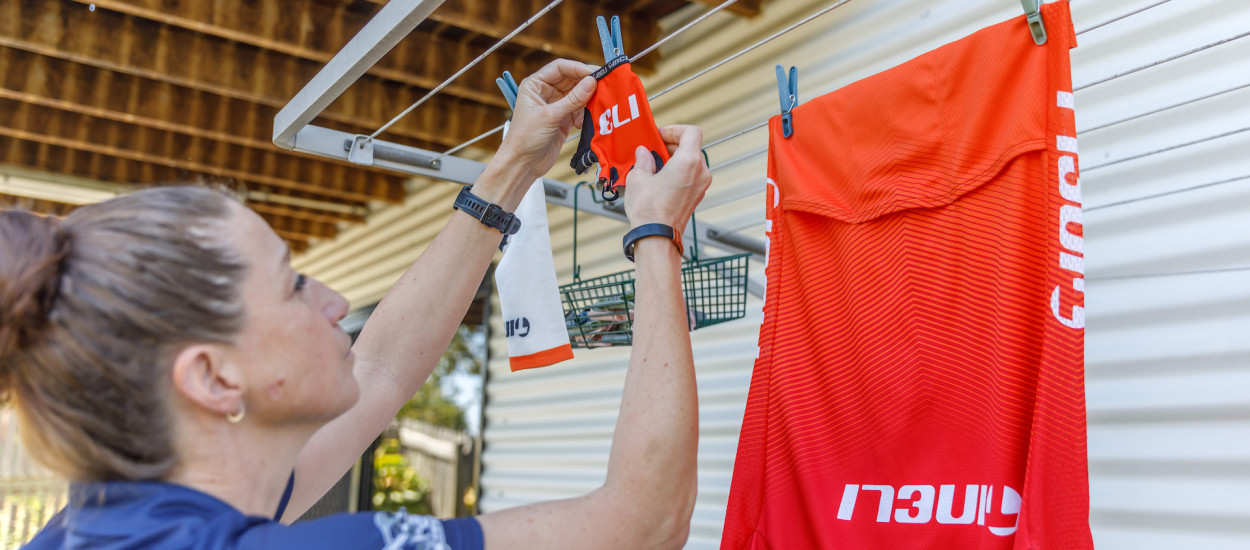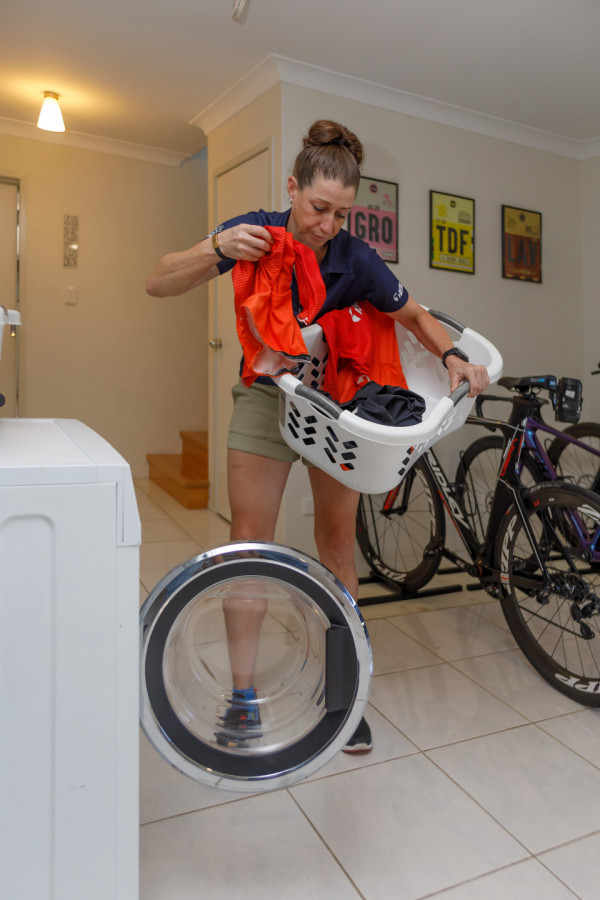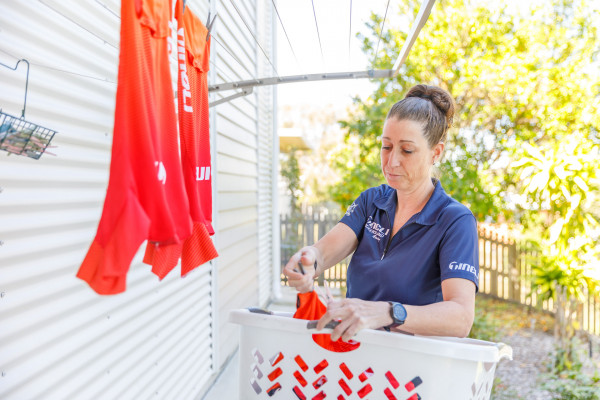How to take care of your cycling clothing

I’m out there training and racing in hot and humid conditions in Queensland (Australia) all year round. Doing sport in hardly-worn new cycling clothing and sweaty high temperatures makes it essential to properly wash and maintain my gear. Here’s what I’ve learned, followed by my top ten tips on prolonging the life and looks of your cycling kit.
What to wash and when to wash It
After a long training ride or hard-out racing, you arrive home worn out, sweaty, and ready for a shower, food, drink and a well-earned rest. Doing your laundry is at the bottom of your to-do list but taking the best care of your cycling kit will significantly extend its lifespan.
These days cycling clothing design is sophisticated, technical and durable, which often means ‘expensive’. So, after parting with your hard-earned dollars to kit yourself out like a pro, you want to make sure your stylish and pricey cycling gear looks great and lasts as long as possible.
Where to start? First up, the care label is there for a reason – so read and memorise it, then follow the washing instructions.
Do you have to wash everything, every time? Thankfully, not every item needs washing after every ride. You only need to wash clothes after each ride that you’ve sweated in, or that got wet and muddy, like jerseys, shorts, arm and leg warmers and socks.
Layered cycling apparel like gloves, winter jackets, rain gear and vests are often fine to wear multiple times. That helps keep their look, elasticity and shape for longer and keeps your bike clothing budget down.

Silvia Smith washing cycling clothing
1. Don’t leave your cycling clothing wet or dirty
If humanly possible, wash your clothes that same day. When sweat, mud and flicked-up road grime dry on your garments, they cling to the high-tech fabric, damaging the knit fibres or leaving permanent stains.
If you can’t put on the wash that day, hang your cycling clothes up in a well-ventilated room so the moisture and sweat can dry out.
2. Pre-wash if you have to
Some riders sweat a lot more than others, which is unfortunately harder on their cycling gear.
If they’re pretty grubby, you can soak your cycling clothes for 30 minutes in cold water before putting them in the washing machine. But don’t leave clothes soaking for hours, it isn’t good for these high-performance fabrics.
3. Hand-wash if you need to
All the experts agree that today’s advanced washing machines with their delicate setting options make handwashing technical performance fabrics unnecessary.
But sometimes you do need to handwash. Wash clothes in cold water using a gentle detergent, then rinse in cold water and air dry inside or outside in the shade.
4. Be kind to your kit
You don’t need to go hard, just choose the gentle or delicate cycle on your washing machine to protect your clothes’ special fabrics. The gentle wash will still deliver a great result. Wash separately from other clothes if you can.
If you do have to combine with other items, take out anything fluffy such as towels. Lint and cotton are attracted to the fibres in technical fabrics and leave them covered in fluff that’s hard to get off.
5. Keep it cool
Hot water is out, with cool or cold water the way to go. The technical and synthetic fibres in today’s advanced cycling garments don’t like hot water, which washes away their insulation, waterproofing and breathability capabilities.
Cold water is easier on the fabrics and better for the environment. It’s also good for washing bright coloured clothing. Wash these with similar colours.
6. Avoid softeners and bleach
It’s tempting to think that fabric softeners, soaking agents, tough detergents or bleach can help your cycling clothes stay looking like new. However, using these chemicals will impact on their wicking fabrics, antibacterial properties and waterproof treatments.
Softeners add a layer to your clothes that inhibits their breathability and can also damage their fibres and elasticity.
7. Zip it up or put it in a bag
Zips or rough surfaces can play havoc with shorts and bibs that need regular washing. Bib shorts can get twisted around in the washing machine, while zips can damage your clothes in the wash.
Always do up zips before washing and use a mesh ‘lingerie’ bag for your bib shorts. It will stop your clothes from getting chewed up, stretched or getting holes ripped in them.
Left undone, Velcro fastenings are brutal on your cycling clothes in the wash. Fasten them securely and put cycling gear with Velcro into their own zipped bag.
8. Let it air dry
Air dry your clothes whenever possible, either on a drying rack or outside. Today’s fabrics dry quickly because of their moisture wicking capabilities.
If you’re drying clothes outside, hang them in the shade (chamois on the outside) so the sun doesn’t fade the colours. If your clothes are in direct sunlight, remember the fabric doesn't like hot temperatures, so don’t leave them out for too long.
9. Wrap it up
You don’t always have the ability to air dry cycling clothes. It’s ok sometimes to tumble dry these at a low heat setting, but don’t do it often, as high temperatures can shrink and damage your garments.
Try this pro-tip – wrap your shorts and jersey in a towel and twist it lightly to soak up the water. Then put them near (never on top of) a heat or ventilation outlet so they can dry as much as possible.
10. Remember the environment
The best thing you can do to be eco-friendly is to have a full load before doing your wash. However, modern machines use much less power and water than earlier models, so are much more efficient.
Use ‘eco-friendly’ detergents with plant-derived ingredients instead of ‘non-bio’ detergents containing petroleum-based surfactants. Another green bonus is that eco-friendly detergents are usually in concentrated form, so you use smaller amounts. Because they’re designed for cooler washing temperatures, they also use less energy.

Silvia Smith washing cycling clothing
About the author
Silvia Smith “Sil” was born in the Netherlands and grew up riding bikes to school, friends and work. She moved to Rockhampton (Australia) in 2000 and riding horses took her interest for the first couple of years. Trying to stay fit when it was raining and she couldn’t ride her horses, Sil started running and this got out of control. After a year of road and trail running she started competing in Ultra Trail Running events within Australia, New Zealand and back in her home country, The Netherlands. She finished nine 100km events and one 100 miler (168km) which took her just under 26 hours to complete and she was first female across the line and 13th overall.
Ultra running is very demanding on the body and Sil started cycling again for cross training. First she bought a road bike, then a Time Trial bike and MTB so she could hit the trails. She now competes in Road Races, MTB short and long distance events and Time Trials throughout Australia.

Silvia Smith